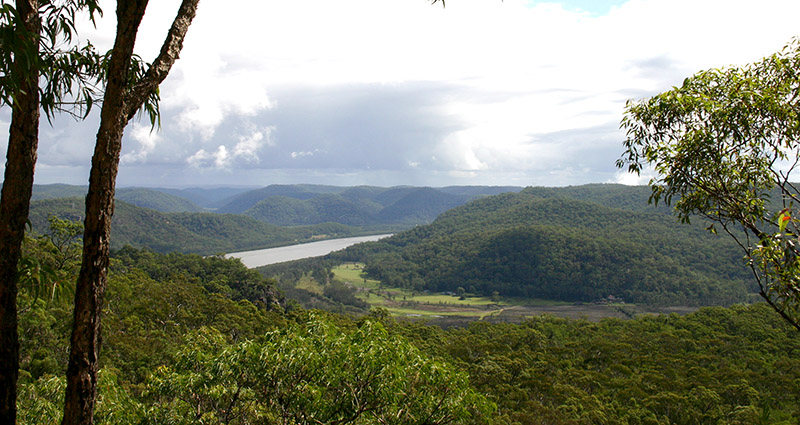Student Resources
The following two water quality resource packages are provided to assist students undertaking senior geography and science projects. They include information and maps on Devlins Creek and Hornsby Creek catchments and include local 10-year datasets from Council’s water quality monitoring program.
Devlins Creek Catchment is one of principal headwater creek sub-catchments located within the larger Lane Cove River Catchment.
The Upper Lane Cove Catchment is one of the four major catchment areas within the Hornsby Shire LGA, alongside the Berowra Creek, Cowan Creek and Hawkesbury River Catchments (refer to Map of the 4 Catchments of Hornsby Shire).
The whole Lane Cove Catchment covers an area of approximately 95.4 square kilometres (9540 hectares). The Lane Cove River is a northern tributary of the Parramatta River, which flows into Sydney Harbour. The Lane Cove Catchment includes seven Local Government Areas, with only the upper reaches of the Lane Cove River located within Hornsby Shire LGA at the top of the catchment.
The Lane Cove River flows generally south for over 15 kilometres from its confluence with Coups Creek in Normanhurst, before merging with Scout Creek within the Lane Cove National Park (near the end of Pennant Hills Park) and with Devlins Creek at North Epping. It is joined by Terrys Creek near Macquarie Park and continues south through Lane Cove National Park before merging with the Parramatta River and Sydney Harbour.
Understanding the Devlins Creek Catchment
The Devlins Creek Catchment is a small sub-catchment of the larger Lane Cove Catchment, encompassing areas generally south of Pennant Hills Road, from Beecroft and Pennant Hills to Carlingford, Epping, and North Epping (refer to Devlins Creek Catchment Maps).
Since May 2016, a significant portion of Devlins Creek Catchment (formerly within Hornsby Shire) now sits within Parramatta City Council LGA. The Devlins Creek Catchment spans approximately 1021 hectares and is shared between Parramatta City Council LGA (705 hectares) and Hornsby Shire Council LGA (315 hectares).
Within Hornsby’s 315 hectares, 71% is zoned residential, and 20% is recreational land-use, with other land-uses being special uses, environmental protection, and business. The M2 Motorway corridor forms the local government boundary between Hornsby Shire and Parramatta City Councils.
The Devlins Creek Catchment is highly developed, dominated by urban land use with some commercial areas, and includes the bushland of Lane Cove National Park. This southern part of Hornsby Shire is the only part of the LGA where stormwater runoff drains south to Sydney Harbour, rather than northwards to the Hawkesbury River.
Devlins Creek, and its principal tributary creekline Byles Creek, are impacted creeks surrounded by an urbanised catchment (sometimes referred to as "urban stream syndrome"). Land use within the catchment, along with human behaviours and environmental impacts from stormwater runoff, play a major role in the state of the waterway and its water quality.
Stormwater runoff is a major threat to the quality of waterways and estuaries in urban areas. Urban runoff can carry litter, sediment, bacteria, nutrients, oils, and heavy metals into waterways. This can make urban waterways unhealthy, unsuitable for swimming, and unable to support sensitive aquatic organisms.
The traditional approach to urban stormwater management has been to channel stormwater into local waterways, often with little regard for the impact. Newer design approaches, like Water Sensitive Urban Design (WSUD), are now being implemented to protect water quality in urban waterways.
Pollution in Devlins Creek
Devlins Creek, like many urban waterways, faces significant pollution challenges. The primary source of pollution is stormwater runoff, which carries a variety of contaminants from the surrounding catchment. This area includes dense urban developments, the Beecroft commercial district, and the Pennant Hills Golf Course.
Sources of Pollution
Stormwater runoff pollutes the creek with both visible and dissolved contaminants. Gross pollutants, such as litter, sediment, and organic matter, are washed into the creek during rainfall or storm events. Less visible pollutants, like nutrients and toxic chemicals, also enter the water, contributing to poor water quality.
Other sources of pollution include potential failures in sewerage infrastructure or dry-weather sewer overflows caused by blockages in the system. Nutrient pollution can come from everyday activities such as overusing fertilisers, washing cars on driveways (with detergents entering stormwater drains), decomposing lawn clippings, pet waste, or sewage overflows.
Impact on Flora and Fauna
Pollution in Devlins Creek significantly affects local plant and animal life:
- Nutrient Overload: Increased nutrients from organic matter raise nutrient levels in the water, depleting oxygen and making it difficult for aquatic life to survive. This process, called eutrophication, can lead to oxygen depletion and excessive algal growth, further harming aquatic ecosystems.
- Sediment Spread: Increased sediment in the water promotes the growth of weeds, which compete with native plants. Fewer native plants lead to reduced habitats for native wildlife, causing a decline in biodiversity.
- Erosion and Habitat Loss: Excessive erosion caused by stormwater runoff carries more sediment into the creek, damaging habitats and reducing the creek’s ability to sustain life.
Water pollution also affects animals differently, with some being more sensitive than others. For example, freshwater crayfish are rarely found in polluted waterways because they prefer clean water. This makes them a useful indicator of a healthy creek system.
What is Being Done to Improve Waterway Health?
Hornsby Shire Council is working to protect and improve the health of local waterways through its Catchments Remediation Rate (CRR) program.
This includes activities such as:
- Water quality monitoring
- Installing stormwater quality improvement devices (SQIDs)
- Stream restoration
- Bushland regeneration
- Street sweeping
- Responding to emergency spills
- Enforcing environmental regulations
- Running community education programs
Stormwater Quality Improvement Devices (SQIDs)
Over 400 SQIDs have been installed across Hornsby Shire to reduce pollution in stormwater. These devices trap litter, sediment, organic matter, and smaller pollutants like heavy metals, rubber particles, and nutrients. Key installations, such as gross pollutant traps and vegetated biofiltration basins, are in areas like Devlins Creek and the upper Lane Cove River catchment.
These devices help capture pollutants before they reach waterways, especially from residential and road runoff. Check out the web map in Further Reading and Resources for locations of the CRR SQIDs.
A key part of preventing stormwater pollution relies on responsible choices by residents and businesses. For example, using a commercial car wash or washing cars on a permeable surface helps reduce runoff. Similarly, managing the use of herbicides, pesticides, and fertilisers in gardens can prevent excess nutrients from entering the stormwater system.
Monitoring Water Quality in Devlins Creek
Hornsby Shire Council undertook monthly water tests within Devlins Creek (i.e. at Site 008 at the end of Sutherland Road, Cheltenham) from October 1994 to September 2017 when it ceased. Sampling Site Location - Site 008 - Devlins Creek
Regular sampling continues at Site 147 Byles Creek tributary (i.e. within the Byles Creek sub-catchment of the Devlins Creek catchment) where data collection has been carried out since 2010. Sampling Site Location - Site 147 - Byles Creek Tributary
10-year Water Quality Datasets – Site 147 Byles Creek tributary (2014-2024) & Site 008 Devlins Creek (2007-2017):
- The accompanying 10-year datasets were collected at Sampling Sites 147 and 008 by Council’s Water Quality Officer and are presented here for your interpretation and analysis of the results.
- Water Quality Data – Byles Creek tributary (Site 147_2014-2024) (PDF version)
- Water Quality Data – Byles Creek tributary (Site 147_2014-2024) (Excel version)
- Water Quality Data – Devlins Creek (Site 008_2007-2017) (PDF version)
- Water Quality Data – Devlins Creek (Site 008_2007-2017) (Excel version)
- Byles Creek Tributary (Site 147) is the only active water quality monitoring site within Devlins Creek Catchment and is located near Day Rd, Cheltenham within the Lane Cove National Park. Site 147 is a small tributary creekline that flows southwards from Pennant Hills Park, entering Byles Creek before its confluence with Devlins Creek.
- Site 147 is used as a water quality Reference Site because it is considered one of the least polluted tributaries in the Lane Cove Catchment. This is mainly due to its location at the catchment headwaters and because the surrounding catchment is predominantly bushland and recreational land-use (i.e. Pennant Hills Park), with little to no significant impact from urban land-use runoff.
- A dataset from this Reference Site is provided as a resource for Senior Geography or Science projects. For example, students could use this dataset as a baseline to compare and contrast water quality data collected from other locations within the Devlins Creek Catchment.
- Please note there are some data gaps present due to issues such as water quality monitoring instrument malfunction and COVID lockdowns.
Further Reading and Resources
Devlins Creek
Lane Cove River
Hornsby Shire Council
- Waterway Health Review Report – 22 Years of Data (See Report and refer to 008 – Devlins Creek, Cheltenham)
- Help protect our waterways: Discover simple ways you can reduce stormwater pollution | Hornsby Shire Council
- Hornsby Shire Council Waterways and Catchments
- What is the Catchment Remediation Rate (CRR) | Hornsby Shire Council.
Web Map
CRR - Map of Hornsby SQIDs (Check out locations of Hornsby’s stormwater quality improvement devices)
Maps
- Map of the 4 Catchments of Hornsby Shire (PDF 812KB)
- Devlins Creek Catchment Map 1_Aerial photo basemap (PDF 785KB)
- Devlins Creek Catchment Map 2_Standard basemap (PDF 616KB)
Hornsby Creek Catchment is one of many small creek sub-catchments located within the larger Cowan Creek Catchment.
The Cowan Catchment is one of the four major catchment areas within the Hornsby Shire LGA, alongside the Berowra Creek, Hawkesbury River, and Lane Cove River Catchments (refer to Map of the 4 Catchments of Hornsby Shire). The catchment includes three Local Government Areas (namely Hornsby Shire, Ku-ring-gai and Northern Beaches Councils).
The Cowan Catchment covers an area of approximately 16,430 hectares in an area bounded by the Hawkesbury River, the Pacific Highway, Telegraph Road Pymble, Mona Vale Road, McCarrs Creek Road, and West Head Road. Approximately 80% of the catchment is protected within the Ku-ring-gai Chase National Park, the second oldest national park in Australia.
The Pacific Highway ridgetop marks its western boundary in Hornsby Shire, while Cockle and Cowan Creeks form the southern and eastern local government boundaries. Land-uses in the southern part of the Catchment include extensive light industrial areas, large commercial shopping centres and developed urban areas.
Understanding the Hornsby Creek Catchment
Hornsby Creek Catchment (HCC) forms part of the larger Cowan Catchment. Covering an area of 334 hectares, HCC includes urban, commercial, and industrial zones and stretches from Waitara to its confluence with Cockle Creek. (refer to the Hornsby Creek Catchment Maps)
Hornsby Creek flows for 2.2 km in a north-easterly direction from around Waitara Station to where it converges with Cockle Creek next to the M2 motorway. Hornsby Creek and Cockle Creek are tributaries of the Cowan Creek estuary.
The catchment is characterised by rapid urbanisation and industrial activities, with growing populations and land-use changes placing significant pressure on its natural resources. Despite these challenges, riparian vegetation and bushland is present along the main creekline with varying degrees of weed infestation and waste accumulation.
The majority of the small tributary feeder creeks flowing into Hornsby Creek have been piped and developed. Several small sections of creekline still remain unpiped and open to the sunlight (e.g. within Edgeworth David Reserve between Burdett Street and Northcote Road, and between Denison Street and Bridge Road).
The land around Leighton Place and Salisbury Road, located adjacent to Hornsby Creek, is essentially an industrial area comprising industrial units suspended on concrete slabs constructed on very steep hills of Hawkesbury Sandstone. The southern section of the catchment, towards Waitara Station, the Pacific Highway and Alexander Parade, is primarily zoned residential and commercial.
Challenges Facing Hornsby Creek
Urbanisation has caused "urban stream syndrome," which impacts creeks by altering water flow, increasing pollution, and harming ecosystems.
Stormwater runoff is the main issue, carrying pollutants like litter, oils, sediments, bacteria, and heavy metals into the creek. These pollutants come from various sources:
- Point sources: Specific discharge locations, like stormwater pipes or industrial sites.
- Diffuse sources: Pollutants washed from large areas, such as shopping malls, roads, parks and yards.
Traditionally, urban stormwater management has focused on channelling stormwater into local waterways to reduce localised flooding, often with little regard for its environmental impact. This approach has contributed to the decline in water quality. However, newer design strategies, such as Water Sensitive Urban Design (WSUD), are being implemented to better protect urban waterways by integrating stormwater management with natural systems.
Specific sources of pollution in Hornsby Creek are not always certain, but the activities and infrastructure within the catchment suggest possible contributors. Monitoring has shown that pollutants from residential areas, commercial zones, and industrial activities are all potential contributors to water quality issues.
Human behaviours also play a significant role in the health of local waterways. Improper disposal of waste, use of chemicals, and poor work practices can exacerbate pollution levels. Even small individual actions, such as littering or washing cars in driveways or on streets, can collectively have a major impact when pollutants are carried by stormwater into the local creek.
A key part of preventing stormwater pollution relies on responsible choices by residents and businesses. For example, using a commercial car wash or washing cars on a permeable surface helps reduce runoff. Similarly, managing the use of herbicides, pesticides, and fertilisers in gardens can prevent excess nutrients from entering the stormwater system.
Water quality monitoring has demonstrated that these stormwater impacts can make urban waterways unhealthy for primary human contact, harmful to sensitive aquatic life, and less able to support ecological balance. The interplay of land use, human activities, and stormwater runoff continues to shape the state of Hornsby Creek and its water quality.
To address these issues, Hornsby Council has implemented a number of waterway remediation projects, including stormwater management infrastructure, community education programs, and sustainable urban design practices. Funding for these initiatives is supported by the Catchments Remediation Rate (CRR), an environmental levy applied across the Shire.
Key Features of Hornsby Creek Catchment
The Hornsby Creek Catchment has distinct physical and land-use characteristics:
Topography and Geography:
HCC generally encompasses the valley running northwards from Waitara Station and the Pacific Highway and situated between Peats Ferry Road (Pacific Highway) to the west and Hornsby Hospital to the east.
The catchment has been extensively cleared and is characterised by gentle undulating crests on sandstone plateau surface slopes with less than 10% vegetation cover. The catchment appears to have been overdeveloped with little consideration of topographic limitations.
The catchment slopes 70 metres from the ridgetop at Waitara to its confluence with Cockle Creek. Many smaller tributaries have been piped and developed. Cockle Creek continues downstream flowing under the M2, through Ku-Ring-Gai Chase National Park before entering the Cowan Creek estuary at Bobbin Head.
Land Use:
- 57% of the catchment is residential.
- 23% is commercial or industrial, including light manufacturing and service industries.
- 4% is open space, which is very low for an urban area.
The southwest portion of the catchment includes retail and auto service industries, while the northeast has general industrial businesses on steep terrain. Hornsby Hospital and other health services dominate the eastern areas. The northwestern section includes a rail depot and high school and there is a significant concrete plant at the centre of the catchment near the creek.
Infrastructure:
26.4 km of stormwater drainage and 47 km of sewerage mains.
Over 100 Stormwater Quality Improvement Devices (SQIDs) such as stormwater pit inserts, trash racks, gross pollutant traps, sediment basins and biofilters help reduce stormwater pollution.
Monitoring Water Quality in Hornsby Creek
Hornsby Shire Council has monitored water quality within Hornsby Creek for more than 30 years. Regular sampling and data collection has been carried out at
Sampling Site 012 - located near where Leighton Place crosses Hornsby Creek (Sampling Site Location - Site 012 Hornsby Creek)
This data has provided valuable insights into the challenges facing the creek and guided efforts to improve its condition.
10-year Water Quality Datasets – Site 012 Hornsby Creek and Site 036 Murray Anderson Creek:
- The accompanying datasets were collected at Sampling Sites 012 and 036 by Council’s Water Quality Officer from 2014 - 2024 and are presented here for your interpretation and analysis of the results.
- Water Quality Data – Hornsby Creek (Site 012_2014-2024) (PDF version)
- Water Quality Data – Hornsby Creek (Site 012_2014-2024) (Excel version)
- Water Quality Data – Murray Anderson Creek (Site 036_2014-2024) (PDF version)
- Water Quality Data – Murray Anderson Creek (Site 036_2014-2024) Excel version)
- Please note there are some data gaps present due to issues such as water quality monitoring instrument malfunction and COVID lockdowns.
- In order to compare and contrast water quality results from the urbanised Hornsby Creek dataset with a more natural National Park creekline we have provided the dataset for Freshwater (Reference) Sampling Site 036 - Murray Anderson Creek, Ku-ring-gai Chase National Park. Both these sites are located within the Cowan Creek Catchment.
- Sampling Site Location - Site 036 - Murray Anderson Creek
Sources of Pollution in Hornsby Creek
Stormwater runoff is a major source of pollution in Hornsby Creek, carrying both visible and dissolved contaminants into the water. During rainfall, gross pollutants such as litter, sediment, and organic matter are washed into the creek. Less obvious but equally harmful pollutants include nutrients (like nitrogen and phosphorus) and toxic chemicals, which degrade water quality.
Everyday activities contribute significantly to pollution. Overusing fertilisers, washing cars on the street (allowing detergents to enter stormwater drains), decomposing lawn clippings, and pet waste all add excess nutrients to the water.
FUN FACT: A medium-sized dog produces around 180 kg of dog poo each year!
Other potential sources of pollution include failures in sewerage infrastructure or blockages that cause dry-weather sewer overflows, further introducing contaminants into the creek.
Efforts to Improve Waterway Health
Hornsby Shire Council’s Catchments Remediation Rate (CRR) program supports several initiatives:
- Water quality monitoring.
- Installing and maintaining SQIDs like gross pollutant traps and biofiltration basins
- Stream restoration and bushland regeneration.
- Street sweeping and responding to spills.
- Community education and enforcing environmental regulations.
Over 400 SQIDs have been installed across the Shire to reduce stormwater pollution. These devices capture litter, sediment, and smaller pollutants before they enter waterways.
Further Reading and Resources:
Hornsby Shire Council
- Waterway Health Review Report – 22 Years of Data (See Report and refer to Site 012 – Hornsby Creek, Hornsby)
- Help protect our waterways: Discover simple ways you can reduce stormwater pollution | Hornsby Shire Council
- Hornsby Shire Council Waterways and Catchments
- What is the Catchment Remediation Rate (CRR) | Hornsby Shire Council.
Web Map
CRR - Map of Hornsby SQIDs (Check out locations of Hornsby’s stormwater quality improvement devices)







